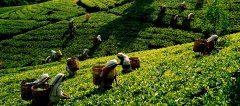Ten kinds of tea that beginners must taste introduction to the taste characteristics of six representative teas
For a first-time tea drinker who is about to explore Chinese tea, hundreds of Chinese teas are undoubtedly overwhelming. In this article, we will introduce the 10 most popular Chinese teas. These will be a good starting point for your Chinese tea trip. In addition, the following teas will cover all six major teas (white, green, black, etc.). 1. Xihu Longjing Tea has no doubt that Longjing green tea is the most popular and famous tea in China. Longjing was originally produced in the West Lake area in the south of Hangzhou. The authentic Longjing tea comes from the legendary Longjing village. In other words, don't ignore Longjing tea produced in other parts of China. Because of the popularity of this kind of tea, other parts of China have also accumulated decades of experience in making excellent Longjing. Buy advice: the cheaper Longjing tea has a nutty and stronger aroma. If this is what you like, there is no need to buy high-end Longjing. Freshness is really important. High-quality Longjing tea (one bud, two leaves or one bud and one leaf) has a light mung bean flavor. When you brew high-quality Longjing, choose a transparent straight cup to appreciate its appearance. Please watch the following video: 2. Biluochun is the second most famous tea after Longjing tea. Its name is inspired by its curly shape, like a snail's house. The original Biluo was produced in the Taihu Lake area of Dongting Mountain in spring. Compared with Longjing tea, Biluochun green tea has stronger plant aroma and floral aroma. If you are looking for a kind of thick green tea, Biluochun is your best starting point. 3. Huangshan Maofeng the last kind of green tea we want to introduce in this article is Huangshan Maofeng. If translated literally, it means "Huang Maofeng". The name is inspired by its origin (Huangshan), its furry and straight appearance. The hairy surface of Longjing tea often disappears because of the intensity of stir-frying, while the lighter processing of Huangshan Maofeng can preserve the white hair on the buds. This is what makes this kind of green tea unique. Biluochun is very popular among tea lovers who like strong tea, while Huangshan Maofeng is loved by people who like delicate and delicate tea. 4. Jasmine tea jasmine tea is probably the most popular Chinese tea abroad. Most jasmine teas are based on green tea and fragrant with jasmine. However, white tea is also often used. Jasmine tea may have different shapes, such as pearls, silver needles, rings, or simple loose leaves. Jasmine flowers may be mixed with leaves, although this is unnecessary. These flowers are mainly used for decoration because their fragrance has been absorbed by the dried tea leaves. 5. Zhengshan race black tea (Zhengshan race)-Jin Junmei black tea when you are looking for a popular black tea, you must start with the tea in Wuyishan area (Fujian Province). This area can be thought of as the Myka of black tea. The most popular kind of black tea in China is Zhengshan race. This kind of tea may have a bad reputation abroad because most of it is low-quality and smoky Zhengshan race black tea exported from China. Fortunately, you can find high-quality versions of black tea with a hint of smoke in China. When you want to explore the popular Chinese black tea, Zhengshan race is the best starting point. Would you like a cup of light black tea? Then have Golden eyebrow black tea. This kind of tea is actually a high-grade Zhengshan race. The name "golden eyebrow" refers to the golden / orange color of dried leaves. Like Huangshan Maofeng green tea, Jin Junmei's leaves are covered with furry hair. Due to the greater processing efforts of black tea, the furry hair has become golden, making its appearance more beautiful. These two kinds of tea are usually processed into honey aroma or more sour longan flavor.

6. Yunnan black tea in the past, tea farmers in Yunnan envied the success of Wuyishan black tea, so they decided to develop their own black tea. The result is a highly aromatic and exquisite Yunnan black tea. Because of its golden appearance, it is also known as "Yunnan gold" in the West. Unlike Wuyi black tea, Yunnan black tea is made of large-leaf varieties, which are also used in Pu'er tea. Yunnan black tea usually tastes finer, tastes lighter and usually lasts longer (when brewed in the traditional way). On the other hand, Wuyishan black tea tastes stronger. Because the leaves are smaller, their taste releases faster. Yunnan red can be made into different shapes: rolled leaves, straight needles (shown in the picture above) and pearls. Some Yunnan black tea may be completely golden, while others are made from a mixture of black and golden leaves. When a Yunnan red contains more gold leaves, it means that it is a kind of high-grade tea. However, appearance is not the only thing that matters. Usually, freshness and craftsmanship are more important than appearance. 7. White Peony & Baihao Silver Needle White Peony is a popular white tea in China. Over the past decade, the popularity of Chinese white tea has soared because of its claimed health benefits. Most white tea comes from Fujian, and Yunnan is now catching up. The most classic varieties of white tea are Baihao Silver Needle and White Peony. The first is the highest grade and the best quality, which consists only of straight furry buds, while the latter may be made up of leaves and buds. Therefore, white peony is more affordable. As you might expect, the taste of silver needle is lighter and more floral, while the flavor of white peony is stronger and more nutty. Finally, there is old white tea. These teas are usually made of baimudan or silver needle tea, steamed and pressed into a cake. Aged white tea may acquire herbal and ripe fruit flavors over time. 8. Unlike green and black tea, Oolong tea is not well known outside China. One of the most famous oolong teas is Tieguanyin. This oolong tea is so tightly rolled that when you pour a few slices into the teapot, it sounds like "iron". Together with jasmine tea and Pu'er tea, it is one of the most widely served teas in Chinese restaurants. Tieguanyin tea is indeed an ideal period; its rich flavor and floral aroma will not be easily overshadowed by food. In addition, the semi-fermentation of the leaves produces a smooth and highly accessible flavor. Unlike fresh green tea, most Tieguanyin teas are not easily astringent. For those who like Chinese green tea, we strongly recommend that we also try this popular oolong tea. 9. Dahongpao tea lovers are likely to end up falling in love with Dahongpao when looking for powerful oolong tea. Its name "Dahongpao" comes from its legend. Its leaves grow under the rocks of Wuyi Mountain. The unique soil of this area makes Dahongpao have this special mineral flavor. Of all the Chinese teas, oolong teas such as Dahongpao are the most difficult to replicate in other tea areas in China. The closest dark oolong tea in another region is Dancong oolong tea from Guangdong, but it is still very different in taste. Wuyishan area produces many sturdy oolong teas (such as daffodils, cinnamon, Doudou, Tieluohan), and the classic Dahongpao may be the best starting point to explore this kind of dark oolong tea. If you want to know more about the classification of Wuyi tea, please click on this link. 10. Finally, there is Pu'er tea (or black tea). It may not be fair to call it tea because it is a category in itself. Because this type of tea has undergone "post-fermentation", it may lead to a wider range of tastes than other types of tea. In addition, the difference between raw and cooked Pu'er tea is also very important. The taste of fresh Pu'er tea is close to that of green tea. Because Pu'er tea will not expire, with the passage of time, its taste will become smoother, less astringent and sweeter. The taste of raw Pu'er tea will change from plant and grass to floral, fruity and herbaceous. On the other hand, mature Pu'er tea is basically made from unprocessed Pu'er tea and goes through an additional wet accumulation process. This produces a completely different taste, characterized by the smell of soil, chocolate, spices, wet straw and forest. Because tea lovers often buy this kind of tea for long-term storage, they prefer to buy tea cakes because they take up less space for storage. For beginners, mature Pu'er tea is usually the best choice to start Pu'er tea journey. Especially if you like oolong tea and black tea. If you like green tea, raw Pu'er tea will be the best choice.
Important Notice :
前街咖啡 FrontStreet Coffee has moved to new addredd:
FrontStreet Coffee Address: 315,Donghua East Road,GuangZhou
Tel:020 38364473
- Prev

Selling coffee in a carriage? The Royal Cup Coffee Brand has been established for 125 years and far beyond Star Buck for 75 years!
Starbucks, everyone knows that. As the world's largest coffee chain, Starbucks is seen as the main representative of the second wave of boutique coffee culture in the United States. Starbucks was founded by Jerry Baldwin, Zev Siegl and Gordon Bowker in Park Market in Seattle in 1971 and has a history of 51 years. Founded in 1966, it entered the Chinese market in 2017.
- Next

What kind of tea is there besides Ceylon black tea in Sri Lanka? The difference between Ceylon CTC black tea and green tea
The tea industry of Ceylon tea started nearly 150 years ago, and Sri Lanka is now the world's fourth largest tea exporter after China, Kenya and India.
Related
- Caught off guard! Starbucks '15-year-old store quietly closes!
- Naixue Drink drank a stone and claimed a claim was retaliated by the merchant?!
- What is the difference between a cake filter cup and a V60 conical filter cup? What are the advantages and disadvantages of the flat-bottomed filter cup brewing solution?
- What is the difference between fine coffee powder and medium coarse coffee powder? Do I need to sift out the fine coffee powder for making coffee by hand?
- Why does hot American coffee taste bitter? Difference in proportional concentration between hot American and ice American
- Is espresso stored overnight in the refrigerator harmful to your body? Is frozen coffee better than freshly ground coffee?
- What parameters and proportions of water temperature should be used to grind and brew fresh coffee beans? Why can't I drink freshly roasted coffee right away?
- Customers have "changed" Manner's new products! Shop assistant: Please don't mess around!
- Remove sockets in customer areas at Starbucks stores?! Netizen: I won't go if I really tear it down
- What is the difference between the taste steps of sun-dried coffee and washed coffee? Why is sun-cured coffee sweeter and washed coffee sour?

